
aplastic anemia PDF
Preview aplastic anemia
APLASTIC ANEMIA, one of the states of Bone Marrow failure Marion S. Sternbach, MD, FRCP(C), FACP Aplastic Anemia - Definition • Aplastic anemia was described by Ehrlich in 1888 in a pregnant woman. • The term is a misnomer, since all three hematopoietic cell lines disappear gradually from the bone marrow without replacement by other cell lines. • This defines it and differentiates it from hematopoietic replacement by : fibrosis, tumors, leukemias, granulomas, fungi, etc. Aplastic Anemia - pathology Marrow Spaces Bony trabeculae All empty Aplastic Anemia (AA) – Classification and Etiology • A. Acquired. • B. Congenital • Incidence : Rare hematological disease in Caucasians 3-5 / Million population/ year. • In Orientals up to 10 - 15 / Million population / year. Aplastic Anemia (AA) – classification and etiology continued • 1. Cytotoxic drugs, organic solvents ( benzene ), fumes, ( lindane, glue vapors), radiation. • 2. Idiosyncratic drug reactions: • Chloramphenicol, • Gold, • Phenylbutazone, Indomethacine, • Sulfa, • Anti-epileptic drugs, • Arsenicals. Aplastic Anemia (AA): classification and etiology continued (3) • 3. Viral Infections: • Parvovirus B 19 – pure red cell aplasia, • Hepatitis: Non-A, non-B, non-C • HIV, • EBV • 4. Immune disorders: • Eosinophilic fasciitis, • SLE, • GVH Aplastic Anemia (AA): classification and etiology, continued (4) • 5. Miscellaneous: • Paroxysmal Nocturnal Hemoglobinuria (PNH) , survival of a more adaptive stem cell population. • Thymoma and Thymic Carcinoma – mostly pure Red Cell aplasia.’ • Pregnancy, most likely immune. Congenital Aplastic Anemias • 1. Fanconi Anemia: > 1850 in literature, • physical findings and chromosome breakages. • 2. Dyskeratosis Congenita: 425 in lit. • Physical findings; telomere shortening. • 3. Diamond-Blackfan anemia 825 in lit. • Pure red cell aplasia, phys. Findings. • Adenosine deaminase deficiency. Congenital Aplastic Anemia continued (2) • 4. Schwachman-Diamond syndrome: • 500 in lit., phys. Findings, malabs., pancreatic insufficiency. Neutropenia. • 5. Severe Congenital Neutropenia: 374 in lit. ; Bone marrow – promyelocyte arrest. • 6. Amegakaryocytic Thrombocytopenia • 100 in lit. No phys. Findings.; absent or abnormal megakaryocytes in BM. Congenital Aplastic anemias continued (3) • 7. Thrombocytopenia, absent radii syndrome: 280 in lit. ; phys. findings – mostly bony. Absent megakaryocytes in bone marrow. • All congenital AA-s have the predisposition to evolve into MDS or leukemia. • Fanconi’s pancytopenia has a special susceptibility for solid tumors.
Description: